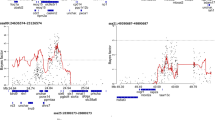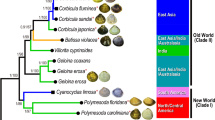Abstract
The relationship between multilocus heterozygosity at protein loci and two fitness traits, growth rate and viability, has been investigated in the European oyster, Ostrea edulis L. A cohort of individuals of the same age was sampled at two times when they were 18 and 30 months old. Weight and genotype for five polymorphic enzyme loci were determined for individuals of these two samples. A positive correlation between growth rate (measured as weight at a specific age) and multilocus heterozygosity is detected in the two age classes. The correlation is statistically significant for the 30-month-old oysters, in which heterozygosity explains about 2 per cent of the variability in growth rate among individuals. This value is very similar to those reported in several marine molluscs, as the American oyster, Crassostrea virginica (Zouros et al., 1980) and the mussel Mytilus edulis (Koehn and Gaffney, 1984), and other species.
The relationship between multilocus allozyme heterozygosity and viability has usually been described in statistical terms, but the viability effects associated with heterozygosity have not been quantified. In this paper, we attempt to measure viability for individuals differing in their degree of multilocus allozyme heterozygosity by using appropriate fitness estimators. In the O. edulis cohort, a decrease of the postsettlement viability estimates is observed when individual heterozygosity increases, and this unexpected pattern might be related to the high mortalities observed. On the other hand, published data of C. virginica and M. edulis, from which a heterozygosity-viability positive correlation was reported (Zouros et al., 1983; Diehl and Koehn, 1985), are used for estimating viability fitnesses for heterozygosity classes. In all three species large differences in estimates of viability and selection coefficients appear to be associated with multilocus allozyme heterozygosity (mean postsettlement viabilities for heterozygous individuals at one or more loci are 0·51±0·12 in O. edulis, 2·68±0·67 and 2·35±0·38 in two populations of C. virginica, and 2·19±0·47 in M. edulis). The extent of the fitness estimates suggests that the magnitude of the association between allozyme heterozygosity and viability is stronger than that corresponding with growth rate in the three species of marine molluscs. The implications of these findings in relation to the genetic mechanism underlying the heterozygosity-fitness correlation are discussed.
Similar content being viewed by others
Article PDF
References
Adamkewicz, L. Taub, B R, and Wall, J R. 1984. Genetics of the clam Mercenaria mercenaria. II. Size and genotype. Malacologia, 25, 525–533.
Alvarez, G. Santos, M, and Zapata, A. 1984. Frequencydependent selection arising from inappropriate fitness estimation. Evolution, 38, 696–699.
Anxolabéhère, D. Goux, J M, and Periquet, G. 1982. A bias in estimation of viabilities from competition experiments. Heredity, 48, 271–282.
Beardmore, J A, and Ward, R D. 1977. Polymorphism, selection, and multi-locus heterozygosity in the plaice, Pleuronectes platessa L. In Christiansen, F. B. and Fenchel, T. M. (eds) Measuring Selection in Natural Populations, Springer-Verlag, New York, pp. 207–221.
Beaumont, A R. Beveridge, C M, and Budd, M D. 1983. Selection and heterozygosity within single families of the mussel Mytilus edulis (L.). Mar Biol Lett, 4, 151–161.
Bush, R M. Smouse, E E, and Ledig, F T. 1987. The fitness consequences of multiple-locus heterozygosity: The relationship between heterozygosity and growth rate in pitch pine (Pinus rigida Mill.). Evolution, 41, 787–798.
Connolly, J, and Gliddon, G. 1984. On the estimation of viabilities in competition experiments. Heredity, 53, 527–543.
Cook, L M. 1971. Coefficients of Natural Selection. Hutchinson Univ. Library, London.
Crow, J F, and Kimura, M. 1970. An Introduction to Population Genetics Theory. Harper & Row, Publishers, New York.
Diehl, L J, and Koehn, R K. 1985. Multiple-locus heterozygosity, mortality, and growth in a cohort of Mytilus edulis. Mar Biol, 88, 265–271.
Elandt-Johnson, R C. 1971. Probability Models and Statistical Methods in Genetics. John Wiley & Sons, New York.
Foltz, D W. Newkirk, G F, and Zouros, E. 1983. Genetics of growth rate in the American oyster: Absence of interactions among enzyme loci. Aquaculture, 33, 157–165.
Foltz, D W, and Zouros, E. 1984. Enzyme heterozygosity in the scallop Placopecten magellanicus (Gmelin) in relation to age and size. Mar Biol Lett, 5, 255–263.
Fujio, Y. 1982. A correlation of heterozygosity with growth rate in the Pacific oyster, Crassostrea gigas. Tohoku J Agric Res, 33, 66–75.
Gaffney, P M, and Scott, T M. 1984. Genetic heterozygosity and production traits in natural and hatchery populations of bivalves. Aquaculture, 42, 289–302.
Gartner-Kepkay, K E. Dickie, L M. Freeman, K R, and Zouros, E. 1980. Genetic differences and environments of mussel populations in the maritime provinces. Can J Fish Aquat Sci, 37, 775–782.
Gartner-Kepkay, K E. Zouros, E. Dickie, L M, and Freeman, K R. 1983. Genetic differentiation in the face of gene flow: A study of mussel populations from a single Nova Scotian embayment. Can J Fish Aquat Sci, 40, 443–451.
Garton, D W. Koehn, R K, and Scott, T M. 1984. Multiplelocus heterozygosity and the physiological energetics of growth in the coot clam, Mulinia lateralis, from a natural population. Genetics, 108, 445–455.
Green, R H. Singh, S M. Hicks, B, and McCuaig, J. 1983. An artic intertidal population of Macoma balthica (Mollusca, Pelecypoda): Genotypic and phenotypic components of population structure. Can J Fish Aquat Sci, 40, 1360–1371.
Koehn, R K. Diehl, L J, and Scott, T M. 1988. The differential contribution by individual enzymes of glycolysis and protein catabolism to the relationship between heterozygosity and growth rate in the coot clam, Mulinia lateralis. Genetics, 118, 121–130.
Koehn, R K, and Gaffney, Y M. 1984. Genetic heterozygosity and growth rate in Mytilus edulis. Mar Biol, 82, 1–7.
Koehn, R K, and Shumway, S E. 1982. A genetic/physiological explanation for differential growth rate among individuals of the American oyster Crassostrea virginica (Gmelin). Mar Biol Lett, 3, 35–42.
Ledig, F T. Guries, R P, and Bonefeld, B A. 1983. The relation of growth to heterozygosity* in pitch pine. Evolution, 37, 1227–1238.
Lewont'N, R C, and Cockerham, M C. 1959. The goodnessof-fit test for detecting natural selection in random mating populations. Evolution, 13, 561–564.
Li, C C. 1959. Notes on relative fitness of genotypes that forms a geometric progression. Evolution, 13, 564–567.
Li, C C, and Horvitz, D. 1953. Some methods of estimating the inbreeding coefficient. Am J Human Genet, 5, 107–117.
Mallet, A L. Zouros, E K. Gartner-Kepkay, E, and Freeman, K R. 1986. Genetics of growth in blue mussels: family and enzyme-heterozygosity effects. Mar Biol, 92, 475–482.
Millar, R H. 1961. Scottish oyster investigations 1946–1958. Depart Agric and Fish for Scotland Mar Res, 3, 1–76.
Mitton, J B, and Grant, M C. 1984. Associations among protein heterozygosity, growth rate, and developmental homeostasis. Ann Rev Ecol Syst, 15, 479–499.
Mitton, J B, and Koehn, R K. 1975. Genetic organization and adaptative response of allozymes to ecological variables in Fundulus heteroclitus. Genetics, 79, 97–111.
Montes, J. Acosta, C P, and Guerra, A. 1988. Oyster mortality in Galicia (N. W. Spain). In De Pauw, N., Jaspers, E., Ackefors, H. and Wilkins, N. (eds) Proceedings Aquaculture Europe ′87. (In press).
Mukai, T. Watanabe, T K, and Yamaguchi, O. 1974. The genetic structure of natural populations of Drosophila melanogaster. XII. Linkage disequilibrium in a large local population. Genetics, 77, 771–793.
Nei, M. 1975. Molecular Population Genetics and Evolution. North-Holland, Amsterdam.
Nei, M. 1978. Estimation of average heterozygosity and genetic distance from a small number of individuals. Genetics, 89, 583–590.
Robertson, A, and Hill, L G. 1984. Deviations from Hardy Weinberg proportions: sampling variances and use in estimation of inbreeding coefficients. Genetics, 107, 703–718.
Rodhouse, P G. McDonald, J H. Newell, R I E, and Koehn, R K. 1986. Gamete production, somatic growth and multiple-locus enzyme heterozygosity in Mytilus edulis. Mar Biol, 90, 209–214.
Roman, G. 1987. Estudio sobre acondicionamiento de la ostra plana (Ostrea edulis L.). Cuad Marisq Publ Tec, 9, 13–39.
Saavedra, C. Zapata, C. Guerra, A, and Alvarez, G. 1987. Genetic structure of populations of flat oyster (Ostrea edulis “Linneo, 1758”) from the NW of the Iberian Peninsula. Inv Pesq, 51, 225–241.
Schaal, B A, and Levin, D A. 1976. The demographic genetics of Liatris cylindracea Michx. (Compositae). Amer Natur, 110, 191–206.
Singh, S M, and Zouros, E. 1978. Genetic variation associated with growth rate in the American oyster (Crassostrea virginica). Evolution, 32, 342–353.
Singh, S M, and Zouros, E. 1981. Genetics of growth rate in oysters and its implications for aquaculture. Can J Genet Cytol, 23, 119–130.
Smouse, P E. 1986. The fitness consequences of multiple-locus heterozygosity under the multiplicative overdominance and inbreeding depression models. Evolution, 40, 946–957.
Sokal, R R, and Rohlf, F J. 1981. Biometry. Freeman and Company, San Francisco.
Strauss, S H. 1986. Heterosis at allozyme loci under inbreeding and crossbreeding in Pinus attenuata. Genetics, 113, 115–134.
Walne, P R. 1964. Observations on the fertility of the oysters (Ostrea edulis). J Mar Biol Ass UK, 44, 293–310.
Wilkins, N P, and Mathers, N F. 1973. Enzyme polymorphism in the European oyster, Ostrea edulis L. Anim Blood Grps Biochem Genet, 4, 41–47.
Workman, P L. 1969. The analysis of simple genetic polymorphisms. Hum Biol, 412, 97–114.
Zouros, E, and Foltz, D W. 1984a. Minimal selection requirements for the correlation between heterozygosity and growth, and for the deficiency of heterozygotes, in oyster populations. Dev. Genet, 4, 393–405.
Zouros, E, and Foltz, D W. 1984b. Possible explanations of heterozygote deficiency in bivalve molluscs. Malacologia, 25, 583–591.
Zouros, E, and Foltz, D W. 1987. The use of allelic isozyme variation for the study of heterosis. In Rattazzi, M. C, Scandalios, J. G. and Whitt, G. S. (eds) Isozymes: Current Topics in Biological and Medical Research, vol. 13, A. R. Liss, New York, pp. 1–59.
Zouros, E. Romero-Dorey, M, and Mallet, A L. 1988. Heterozygosity and growth in marine bivalves: further data and possible explanations. Evolution, 42, 1332–1341.
Zouros, E. Singh, S M. Foltz, D W, and Mallet, A L. 1983. Post-settlement viability in the American oyster (Crassostrea virginica): an overdominant phenotype. Genet Res, 41, 259–270.
Zouros, E. Singh, H M, and Miles, H E. 1980. Growth rate in oysters: an overdominant phenotype and its possible explanations. Evolution, 34, 856–867.
Author information
Authors and Affiliations
Rights and permissions
About this article
Cite this article
Alvarez, G., Zapata, C., Amaro, R. et al. Multilocus heterozygosity at protein loci and fitness in the European oyster, Ostrea edulis L.. Heredity 63, 359–372 (1989). https://doi.org/10.1038/hdy.1989.110
Received:
Issue date:
DOI: https://doi.org/10.1038/hdy.1989.110
This article is cited by
-
Food regime modulates physiological processes underlying size differentiation in juvenile intertidal mussels Mytilus galloprovincialis
Marine Biology (2016)
-
Multilocus heterozygosity and sexual selection in a natural population of the marine snail Littorina mariae (Gastropoda: Prosobranchia)
Heredity (1995)
-
Allozyme variation in European populations of the oyster Ostrea edulis
Marine Biology (1993)



